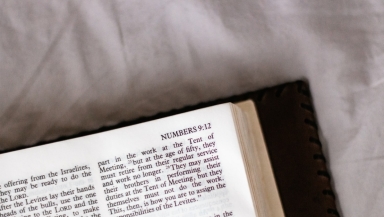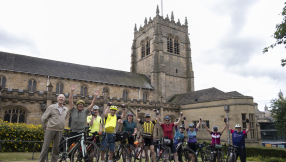
Hebrew scholar and Jewish academic Irene Lancaster reflects on Numbers, leadership and destiny.
The upcoming Torah reading is packed with information and insights. Let's look at one of two of them that have, to say the least, caused some controversy.
Parshat Chukkat (Numbers 19:1-22:1) discusses the death of Miriam and Aaron. In Numbers 20:1, Miriam dies 'in the first month', i.e. the spring month of Nissan. She dies and is buried in 'the wilderness of Zin' and the people settled in Kadesh (meaning 'holiness').'
Immediately on Miriam's death 'there was no water (v 2).' What is the reason for this juxtaposition of her death and 'no water'? The great French commentator Rashi (1040-1105), basing himself on a comment in Talmud Taanit 9a, states that a miraculous well had followed the people throughout their wanderings, providing a plentiful supply of fresh water. As soon as 'that righteous woman' died, the water stopped, with the disastrous consequences found later in verses 9-13.
It should be added that Miriam's name is composed of the word for 'water' and the word for 'bitter', i.e. 'contentious'. Thus, from birth, Miriam was destined to symbolise both a life-giving substance and strife. Her link to water is clear from the Exodus episodes of saving baby brother Moses (Exodus 2: 4-10) and her Song of the Sea on the Exodus from Egypt (Exodus 15:20-21).
'There was no water for the edah and they gathered against Moses and Aaron (v 2).' 'The people quarrelled/strove with Moses and spoke up ...'(v 3).'
What is an edah? The word is related to 'witness' or 'testimony'. So it implies a unity of intent. The people were all thirsty and scared for the future and they spoke with one voice.
Moses is instructed by G-d to go with Aaron and 'speak to the rock before their eyes and then it will give its waters (v 8).' In verses 9-13, Moses and Aaron err and are punished for striking the rock instead of speaking to it.
In v 12, G-d tells Moses and Aaron that 'Because you did not believe in Me to sanctify Me in the eyes of the children of Israel, therefore you will not bring this kahal to the land that I have given them.'
What is a kahal? Kahal is often used as a synonym for edah. However, the stress here is more on community than on unity. Earlier, the people were united in their need for water. Now, however, about to cross over into the Land, they behave as a community with some type of togetherness - maybe - but with different needs and aspirations. G-d adds that these waters are 'waters of strife' - Meribah (v 13), thus alluding to Miriam's two aspects.
On a positive, but perhaps contentious note, contention has always been part of the Jewish makeup and is regarded positively when it is channelled into learning ('two Jews - three opinions') or debate. A pristine state of pure peace and equanimity does not exist in Judaism. Mostly, this state of equilibrium is regarded as an excuse for sitting on the sidelines and not acting when action is necessary.
In verses 14-21 it is time for the children of Israel to enter the Land, but their neighbour, Edom, refuses access. Thus, we see that Jacob's twin brother Esau, still bears a grudge after all these years. Much of the ancient territory of Edom, home to the descendants of Esau, falls within the border of the modern-day southern part of Jordan and southern Israel.
On October 26, 1994, in Wadi Arabah, on the border of what was previously the territory of Edom, Israel and Jordan signed a peace treaty. Chief Rabbi Shear Yashuv Cohen of Haifa, who had been wounded and imprisoned by the Jordanians in the 1947-48 War of Independence, was asked by Prime Minister Yitzhak Rabin to give the address before the King of Jordan and US President, Bill Clinton. He decided to recite Psalm 121: ' ... my help comes from the Lord, maker of the heavens and the earth.'
Later, the Chief Rabbi explained that 'the Jewish people's trust is not in peace treaties or in flesh-and-blood leaders, but only in the Holy One, Blessed be He.' (See my English-language version: Rabbi Shear Yashuv Cohen: Between War and Peace, pg 269).
Verses 22-29 discuss the death of Aaron at the age of 123 on 1st Av (this year Shabbat July 26) in the 40th year of Israel's wanderings. Aaron dies on Mount Hor ('the mountain of mountains') and his son Elazar takes on his mantle as High Priest. In v 24 and v 26, G-d states that Aaron will be 'gathered in'. This is not the same verb as the one used in v 2, when 'they gathered against Moses and Aaron', because there was no water.
This gathering in verb is asaph, which is used only five times in the Hebrew Bible to depict the aftermath of death. These are in relation to the deaths of Abraham, Isaac, Jacob, Moses (later) and Aaron here. These are the first leaders of the Jewish people - the three Patriarchs, followed by Moses and Aaron.The great grammarian and Spanish Bible scholar and scientist, Rabbi Abraham in Ezra (1089-1164) states in his commentary on Genesis 25:8, referring to the death of Abraham: 'Some say that this refers to the kavod of the soul. As long as it [the soul] is functioning in the body, it is as if it is a divided and separate entity. When it [the soul] is separated from the body, the kavod is gathered to its people.' The term 'kavod' has a special meaning in ibn Ezra, similar to 'the link to the divine'.
Rabbi David Zvi Hoffmann (1843-1921) comments further: 'All these expressions indicate that among the people of Israel there always existed a belief in life after death. Death was not perceived as annihilation, but rather as a reunion with one's ancestors or with members of the nation who had already departed, all of whom became united in the World of Truth.'
The translation of asaph as 'reunite' is probably the most accurate. Jewish people are often asked what Judaism has to say about life after death. We tend to be reticent, very aware that other religions have an extremely intricate, if not violent, depiction of these matters. But in fact, the precursors of the rabbis, i.e. the Pharisees, were the first to introduce the idea of resurrection of the dead to the monotheistic world. Non-discussion of this issue in public does not imply indifference, or even non-belief.
For more than 2,000 years the Jewish people have had to contend with hostile peoples and religions both inside and outside their domiciles. Only today in the resurrected State of Israel are Jews really free to acknowledge what they themselves have initiated. Up until now, Jews had to play down a number of notions integral to the religion, simply in order to survive.
The lesson to draw from Shabbat's upcoming reading is that the siblings Miriam, Aaron and Moses were not 'perfect'. But their humanity shines through in everything they did. Miriam saved the marriage of her parents. She saved the life of her baby brother, Moses. She led the Jewish women. Aaron understood his people and therefore occasionally erred on the side of indulgence when discipline was called for. Moses couldn't communicate as well as Aaron, and therefore needed him to deal with the people.
We have been reminded this week that leadership is very difficult indeed. Sometimes leaders break down, or become ill. The leadership in Israel has always to contend with internal and external divisions that would break lesser human beings.
The most mature test of leadership is to know when to step down and leave the mantle to others. G-d told Moses and Aaron that they had done their bit. Now the children of Israel would be self-sufficient in the Promised Land, with a succession of leaders, starting with Joshua. But that is a story for a later date.
As Alistair Heath, editor of the Sunday Telegraph, stated in a recent article: 'Maybe the Jews are not a people ... but a testimony ... Israel's survival isn't just impressive, but divine ... G-d keeps His promises and He's keeping them still.'
And it all started with the story here in Numbers 1:20 of the incipient new nation of straggling Jews bearing witness to the fact that, in the midst of all their quarrels and disputations, sometimes they could come together and, with the help of G-d, continue to write their own destiny.













